Monique De Rae has developed a vocation for painting since her childhood, and she has later set aside a degree and a job in clinical chemistry to devote herself full-time to painting.
This is the draft of the speech I delivered, when called to present the exhibition The Blue-Eyed Lady at the Francesco Gonzaga Museum in Mantua on 2 July 2020.
Articolo originariamente scritto in italiano.
For a long part of her artistic career, her production has been fairly traditional: oil and watercolour still lives, animals and water panoramas. Those oil and watercolour paintings show her assimilation of the Flemish tradition (how not to think of Van Gogh in the various seascapes or bouquets of flowers?), but also of French post-impressionism (Cezanne, the Nabis or the Fauves) and naïve art (her animals here in Italy can easily remind of Ligabue).
All of this however, though well done and rooted in tradition, was just a deja vu and was not enough to her, and she has then decided to change route.
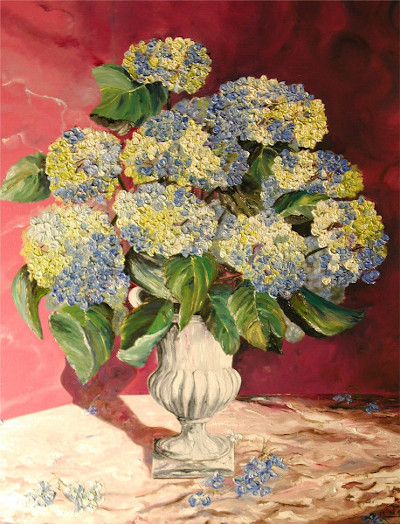
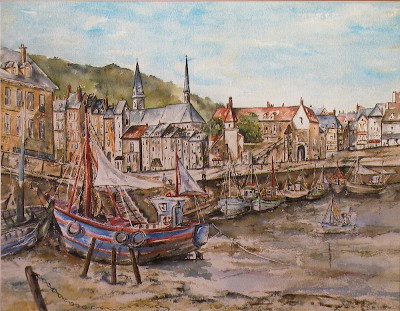
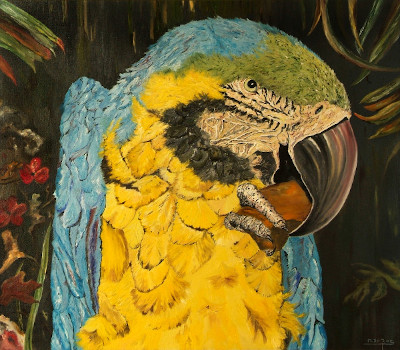 As Monique De Rae tells, it all started with her giant apricot-coloured female poodle named Lady, whose head was regularly adorned with a cheery ribbon. Lady was always attracting the curiosity and sympathy of the people she met, and she was also looking like observing the world in order to understand it, with the expression dogs have when they are waiting for a sign of involvement from their owners. Lady too has been occasionally portrayed in the first artistic phase.
As Monique De Rae tells, it all started with her giant apricot-coloured female poodle named Lady, whose head was regularly adorned with a cheery ribbon. Lady was always attracting the curiosity and sympathy of the people she met, and she was also looking like observing the world in order to understand it, with the expression dogs have when they are waiting for a sign of involvement from their owners. Lady too has been occasionally portrayed in the first artistic phase.
When Lady died, her searching gaze came back as an echo to Monique's mind. At the same time, but independently of Lady's death, the attention to the social dynamics emerged strongly and something started: as a conversion on the road to Damascus, Monique definitively abandoned her traditional painting to make way for something radically new in terms of technique, subjects and approach.
What is most immediately visible is the technical and figurative metamorphosis. The many subjects become one: Lady. The dog is outlined in a crouched pose, listening and observing; colours become flat and bright, almost primary. The dog itself is yellow (recalling its apricot colour) and the eyes are blue (to indicate clarity and brightness).
It might still look like a wink to tradition (the Fauves, for example), but it is something new: shapes are simplified, almost abstract, in a process that closely reminds the graphics of the early 20th century or, even more so, those of the first video games. It is not an imitation, but the refining process is similar: everything superfluous disappears and all that remains are flat and intense colours, clear and simple lines, clear letters.
And the transformation happens overnight, without any intermediate evolutionary steps.
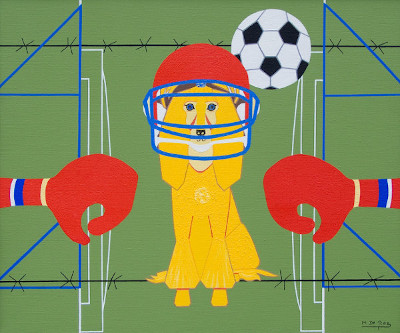
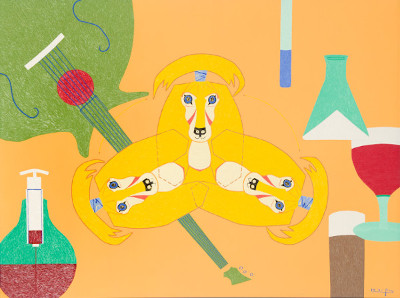
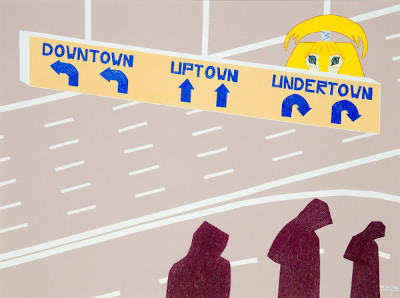 The change, as mentioned, is also in subjects: the focus shifts from landscapes and postcards to social issues, from the observation of nature to the observation of human beings. And it takes a fairy-tale dimension, concerning the approach more than the story. Lady becomes something like a medium, like the ventriloquist's puppet that in so many movies and in so much literature is just the mask of the man who moves it, his link with the world. The outlined shape of Lady becomes the starting point for each canvas; always in the same pose, colour and size, her silhouette is the centre of and creates the space in which the outlined elements of each painting are distributed.
The change, as mentioned, is also in subjects: the focus shifts from landscapes and postcards to social issues, from the observation of nature to the observation of human beings. And it takes a fairy-tale dimension, concerning the approach more than the story. Lady becomes something like a medium, like the ventriloquist's puppet that in so many movies and in so much literature is just the mask of the man who moves it, his link with the world. The outlined shape of Lady becomes the starting point for each canvas; always in the same pose, colour and size, her silhouette is the centre of and creates the space in which the outlined elements of each painting are distributed.
At the same time, the painting is accompanied by a text, a sort of apologue that takes up, rather than illustrating, the elements of the painting. A light reprise integrating the scene to complete the narration, that in Italy could remind of the dialogue between Gianni Rodari's stories and Bruno Munari's drawings in the unforgettable Einaudi white series.
Apparently this sometimes critical attention to society may seem snooty, a Cato's like attitude, as many ones are unfortunately seen every day. But this would be a wrong impression, as Monique is not judging; she is fully immersed in the world and in the difficulties of our time, she is "one of us".
And you can understand it when you see how, on closer inspection, each of her works (at this point to be understood as a combination of painting and apologue) is imbued with an optimism that always prevails over criticism; how much she wants to convey a constant, friendly and optimistic invitation to get up and get moving, starting from the small everyday things. Because, as she says, today's real results have been produced by yesterday's idealists.
Contatti
📞🖭 +39 0376 158 6243
📨 mantovaguide@litterae.eu
Lingua
🇮🇹 Italiano
🇬🇧 English
🇫🇷 Français
🇪🇸 Español
Cerca
Hanno detto
![]() I thoroughly enjoyed my tour with you and my time in your beautiful country - Jane B, USA
I thoroughly enjoyed my tour with you and my time in your beautiful country - Jane B, USA
Argomenti
Alberti arazzi archeologia architettura Beltrami cucina duomo Federico II Gonzaga filatelia folclore fotografia Giulio Romano informatica Isabella D'Este Lanfranco libri Mantegna Matilde di Canossa Monteverdi mostre Museo Francesco Gonzaga musica natura Palazzo D'Arco Palazzo della Ragione Palazzo Ducale Palazzo Te Piazza Sordello pittura Raffaello Sabbioneta Sant'Andrea Santa Barbara scultura sport storia street art Tiziano Unesco Verdi Vincenzo Gonzaga Zandomeneghi
Rubriche
Il punto
Informazioni utili
Lampi di stampa
Mostre passate
Mostre virtuali
Twittagram
Letture
Leone de' Sommi Teatro
Ricorrenze mantovane
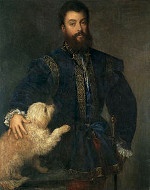 Il 1° luglio 1521 papa Leone X nomina Federico II Gonzaga capitano dell'esercito pontificio
Il 1° luglio 1521 papa Leone X nomina Federico II Gonzaga capitano dell'esercito pontificio
Segui
Rete
© Mantova Guide 2009-2025. All rights reserved. Site design by Litterae.eu.
Info GDPR EU 2016/679: no cookies used, no personal data collected.
p.iva / vat number: 02757940206